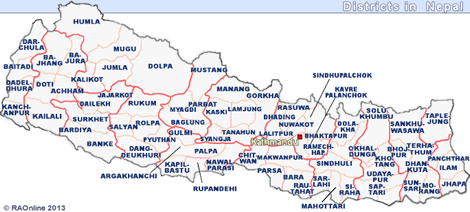|
The
Maoists' Stratgegy and Tactics |
The
Maoist movement has suddenly moved to fast-forward. When the Communist
Party of Nepal (Maoist) held its second convention in Dang in February,
the party announced a new Prachanda Path doctrine calling for a "mass uprising"
in urban areas to take the revolution forward. A
t the vanguard would be
Maoist front organisations of students, women and workers. The Maoists
had banked on the street protests escalating that followed the Royal
massacre of 1 June 2001. But the party's strategy has failed. There just
wasn't enough critical mass in the protests for the Maoists to instigate
an urban uprising. The Maoists have changed their strategy, which is to
foment confusion in urban areas by using "banner bombs" - booby trapped
explosives hanging from big banners denouncing the new king and the prime
minister.
The party was planning to declare a "regional peoples' government"
in the areas in midwest Nepal under their control. The next step soon after
would be announcing a parallel national interim government like they
have done in the districts under their control. So, the Maoists continue
their presence in Kathmandu, through booby traps, infiltration of protests
against the public security regulations. In the countryside, Maoist forces
continue their attacks on police posts and army barracks. The Maoists will
also keep taunting the Army, try to infiltrate its ranks to bring down
morale and stoke disunity. The Maoists know that sooner or later they will
have to take on the Army.
The other characteristic of the Prachanda Path
doctrine is the fusion of the "mass uprising" in urban areas with the "peoples
war" in the hinterland. The Maoists have declared eight districts in Bheri,
Karnali and Rapti Zones as having "peoples' governments" and they appear
to be consolidating their hold on districts on the periphery like Dang,
Bajura and Dailekh. Maoists are also abducting and attacking security personnel
which brings them valuable manpower and weapons.
Earlier the Maoists'
collection of taxes and donations were aimed at medium and large businesses
and their targetting corrupt local officials were populist. However, the
extortion is getting indiscriminate and hurting the not-so-well-off, and
many popular local figures and elected officials have been brutally killed
just for daring to oppose local Maoists. The fact that the Maoists' tactics
have changed so frequently is seen by some as confusion and differences
in the ranks. The Maoists are now trying to prepare for a big confrontation.
top
The
Maoist's new guerrilla tactics 2002
Destroying
infrastructure and attacking key security posts |
The
Maoist's new guerrilla tactics: Destroying infrastructure and attacking
key security posts
The
Maoists had recently concentrated on attacking electric power plants, schools,
road links, bridges, local government offices and other parts of Nepal's
infrastructure. The latest attacks show Maoists are still adept at using
darkness and terrain to strike hard at security forces.
top
| Maoist
attacks on infrastructure leaves nation high and dry |
The
Maoist forces are launching lethal attacks on hydropower installations,
drinking water pipelines, irrigation facilities, health posts and bridges.
 In
Jajarkot Khalanga , the headquarters of Jajarkot district, Maoist
rebels damaged the 80-year-old water supply system. There is no drinking
water in district headquarters after the rebels cut off water supply lines.
Prior to that, Maoists damaged drinking water networks in Okhaldhunga,
Achham, Bajhang, Sindhupalchok and Pyuthan. The district authorities have
not enough money to repair the damaged supply lines. In
Jajarkot Khalanga , the headquarters of Jajarkot district, Maoist
rebels damaged the 80-year-old water supply system. There is no drinking
water in district headquarters after the rebels cut off water supply lines.
Prior to that, Maoists damaged drinking water networks in Okhaldhunga,
Achham, Bajhang, Sindhupalchok and Pyuthan. The district authorities have
not enough money to repair the damaged supply lines.
 The
headquarters of at least six districts - Khandbari of Sankhuwasabha, Bhojpur,
Taplejung, Phidim of Panchthar, Okhaldhunga, Dhading - have been forced
to plunge into absolute darkness after the Maoist attacked small hydro
installations there. The Maoist forces also attacked the 12 MW Jhimruk
hydroelectric plant. The personnel was warned by the rebels not to repair
it. The
headquarters of at least six districts - Khandbari of Sankhuwasabha, Bhojpur,
Taplejung, Phidim of Panchthar, Okhaldhunga, Dhading - have been forced
to plunge into absolute darkness after the Maoist attacked small hydro
installations there. The Maoist forces also attacked the 12 MW Jhimruk
hydroelectric plant. The personnel was warned by the rebels not to repair
it.
 The
Maoist attacks on control towers of the Civil Aviation Authority of Nepal
in the country's most inaccessible areas in the mid- and far west has forced
hundreds of thousands of people to remain isolated from rest of the country.
The state-owned Royal Nepal Airlines Corporation has been forced to cancel
its flights to at least six districts in the same region. The airports
that have remained largely disfunctional include Chaurjahari airport in
Rukum, Sanphebagar airport in Achham, Bajura airport, Baitadi and Darchula
airport. The
Maoist attacks on control towers of the Civil Aviation Authority of Nepal
in the country's most inaccessible areas in the mid- and far west has forced
hundreds of thousands of people to remain isolated from rest of the country.
The state-owned Royal Nepal Airlines Corporation has been forced to cancel
its flights to at least six districts in the same region. The airports
that have remained largely disfunctional include Chaurjahari airport in
Rukum, Sanphebagar airport in Achham, Bajura airport, Baitadi and Darchula
airport.
 Rebels
damaged two bridges in Bardiya district. The attacks on a bridge over the
Mana river connecting Bardia with Banke, and a pontoon bridge over the
Karnali river connecting Kothiyaghat with Rajapur's 11 villages, have directly
being an impact on thousands of people in the mid-western Terai. Rebels
damaged two bridges in Bardiya district. The attacks on a bridge over the
Mana river connecting Bardia with Banke, and a pontoon bridge over the
Karnali river connecting Kothiyaghat with Rajapur's 11 villages, have directly
being an impact on thousands of people in the mid-western Terai.
 The
rebel attacks have also affected the country's telecommunication network.
Thanks to the attacks on repeater and marts stations, telecommunication
facilities in 16 districts cease to exist. Over 90 telecom stations have
already been destroyed by the rebels. NTC The
rebel attacks have also affected the country's telecommunication network.
Thanks to the attacks on repeater and marts stations, telecommunication
facilities in 16 districts cease to exist. Over 90 telecom stations have
already been destroyed by the rebels. NTC
 The
rebel attacks and plundering of small banking facilities around the country
has also affected the developmental projects of the United Nations Development
Programme (UNDP) and other non-governmental organisations (NGOs). The
rebel attacks and plundering of small banking facilities around the country
has also affected the developmental projects of the United Nations Development
Programme (UNDP) and other non-governmental organisations (NGOs).
top
| Mid-western
region hardly affected be Maoist's destructions |
The
people of the Mid-western Development Region have been badly affected by
the violent activities unleashed by the Maoists. Thousands of people of
Banke, Bardiya, Dang, Dailekh, Dolpa, Kalikot, Mugu, Jumla, Pyuthan, Rolpa,
Rukum, Salyan, Surkhet and Jajarkot districts of the Mid-western Development
Region have been rendered homeless as a result of the terrorist activities
of the Maoists. About 2,000 people including Royal Nepalese Army and police
personnel, and ordinary people have lost their lives. Air services
to Jufal of Dolpa, Choujahhari of Rukum, Kolti of Bajura and Sanfebagar
of Achham have been stopped after the Maoist rebels destroyed the airport
tower and office. Problems have been faced in supplying essential and other
commodities after the closure of air services being operated for the benefit
of the people of these four remote districts.
Telecommunications
services in Jumla, Kalikot, Jajarkot, Rukum, Rolpa and other districts
excluding Pyuthan and Salyan districts have been disrupted after the Maoist
forces destroyed the telecommunication repeater station and towers.
Maoists
have also totally destroyed the office, machinery and other materials used
for building the road from Chhinchu to the headquarters of Jajarkot district
and delayed construction work of the road.
The
Maoist terrorists have caused a loss of billions of rupees by destroying
the development infrastructures in the headquarters of Dang district and
the Jhimruk Hydroelectricity Project of Pyuthan district. The destructions
of health posts, drinking water and electricity projects, bridges and police
posts had a negative impact on the overall development of the Mid-western
Development Region. The Maoists have pushed the Mid-western Development
Region backwards for many years.
Australia:
Maoist tactics flayed
Australian
Foreign Minister has condemned the recent Maoist tactics of targeting the
telecommunication infrastructure. He has also flayed the recent tactics
whereby the rebels have widened their sphere of activity to blocking food
supply to Humla and Jumla. Their tactics of attacking the hydropower stations,
drinking water facilities, pipelines and bridges too have come under fire.
The Australian FM has also condemned the instances of kidnappings and torture,
execution and intimidation of common people.
top
|

![]() In
Jajarkot Khalanga , the headquarters of Jajarkot district, Maoist
rebels damaged the 80-year-old water supply system. There is no drinking
water in district headquarters after the rebels cut off water supply lines.
Prior to that, Maoists damaged drinking water networks in Okhaldhunga,
Achham, Bajhang, Sindhupalchok and Pyuthan. The district authorities have
not enough money to repair the damaged supply lines.
In
Jajarkot Khalanga , the headquarters of Jajarkot district, Maoist
rebels damaged the 80-year-old water supply system. There is no drinking
water in district headquarters after the rebels cut off water supply lines.
Prior to that, Maoists damaged drinking water networks in Okhaldhunga,
Achham, Bajhang, Sindhupalchok and Pyuthan. The district authorities have
not enough money to repair the damaged supply lines. ![]() The
headquarters of at least six districts - Khandbari of Sankhuwasabha, Bhojpur,
Taplejung, Phidim of Panchthar, Okhaldhunga, Dhading - have been forced
to plunge into absolute darkness after the Maoist attacked small hydro
installations there. The Maoist forces also attacked the 12 MW Jhimruk
hydroelectric plant. The personnel was warned by the rebels not to repair
it.
The
headquarters of at least six districts - Khandbari of Sankhuwasabha, Bhojpur,
Taplejung, Phidim of Panchthar, Okhaldhunga, Dhading - have been forced
to plunge into absolute darkness after the Maoist attacked small hydro
installations there. The Maoist forces also attacked the 12 MW Jhimruk
hydroelectric plant. The personnel was warned by the rebels not to repair
it. ![]() The
Maoist attacks on control towers of the Civil Aviation Authority of Nepal
in the country's most inaccessible areas in the mid- and far west has forced
hundreds of thousands of people to remain isolated from rest of the country.
The state-owned Royal Nepal Airlines Corporation has been forced to cancel
its flights to at least six districts in the same region. The airports
that have remained largely disfunctional include Chaurjahari airport in
Rukum, Sanphebagar airport in Achham, Bajura airport, Baitadi and Darchula
airport.
The
Maoist attacks on control towers of the Civil Aviation Authority of Nepal
in the country's most inaccessible areas in the mid- and far west has forced
hundreds of thousands of people to remain isolated from rest of the country.
The state-owned Royal Nepal Airlines Corporation has been forced to cancel
its flights to at least six districts in the same region. The airports
that have remained largely disfunctional include Chaurjahari airport in
Rukum, Sanphebagar airport in Achham, Bajura airport, Baitadi and Darchula
airport. ![]() Rebels
damaged two bridges in Bardiya district. The attacks on a bridge over the
Mana river connecting Bardia with Banke, and a pontoon bridge over the
Karnali river connecting Kothiyaghat with Rajapur's 11 villages, have directly
being an impact on thousands of people in the mid-western Terai.
Rebels
damaged two bridges in Bardiya district. The attacks on a bridge over the
Mana river connecting Bardia with Banke, and a pontoon bridge over the
Karnali river connecting Kothiyaghat with Rajapur's 11 villages, have directly
being an impact on thousands of people in the mid-western Terai. ![]() The
rebel attacks have also affected the country's telecommunication network.
Thanks to the attacks on repeater and marts stations, telecommunication
facilities in 16 districts cease to exist. Over 90 telecom stations have
already been destroyed by the rebels. NTC
The
rebel attacks have also affected the country's telecommunication network.
Thanks to the attacks on repeater and marts stations, telecommunication
facilities in 16 districts cease to exist. Over 90 telecom stations have
already been destroyed by the rebels. NTC ![]() The
rebel attacks and plundering of small banking facilities around the country
has also affected the developmental projects of the United Nations Development
Programme (UNDP) and other non-governmental organisations (NGOs).
The
rebel attacks and plundering of small banking facilities around the country
has also affected the developmental projects of the United Nations Development
Programme (UNDP) and other non-governmental organisations (NGOs).




